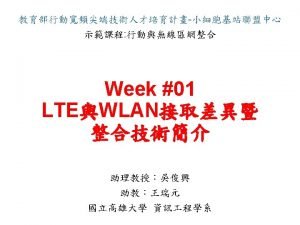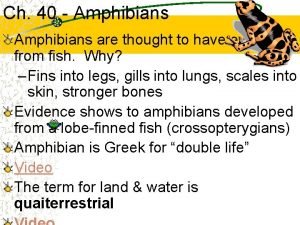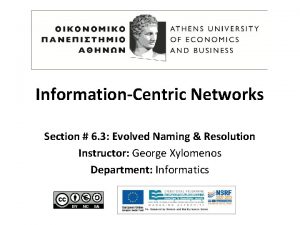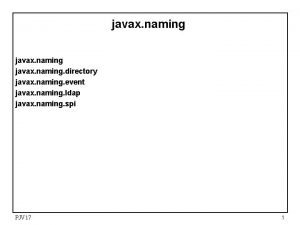InformationCentric Networks Section 6 2 Evolved Naming Resolution











- Slides: 11

Information-Centric Networks Section # 6. 2: Evolved Naming & Resolution Instructor: George Xylomenos Department: Informatics

Funding • These educational materials have been developed as part of the instructors educational tasks. • The “Athens University of Economics and Business Open Courses” project only funded the reformatting of these educational materials. • The project is being implemented as part of the Operational Program “Instruction and Lifelong Learning” and is cofinanced by the European Union (European Social Fund) and national funds.

Licencing • These educational materials are subject to a Creative Commons License.

Week 6 / Paper 2 • A layered naming architecture for the Internet – Hari Balakrishnan, Karthik Lakshminarayanan, Sylvia Ratnasamy, Scott Shenker, Ion Stoica and Michael Walfish – ACM SIGCOMM 2004 • Main point – There is one step of name resolution today: DNS to IP – There should instead be three • User name to service identifier • Service identifier to endpoint identifier • Endpoint identifier to IP address – This would make data and services equal to hosts • It would also accommodate mobility and multihoming • And properly integrate middleboxes into the Internet Information-Centric Networks 06 b-4

Introduction • There are two namespaces on the Internet: DNS and IP – DNS is tied to administrative structure, IP to network topology – Data and services are only named indirectly • We name the host where data and services reside • They are thus tied to administrative structure and network topology – Middleboxes violate even this simple model • NATs/NAPTs modify the IP addresses • Ideally they should be explicitly delegated to do their job • What should naming be like? – We really need four layers of naming • Human names, service IDs, endpoint IDs and IP addresses – Naming is relatively easier to modify than IP itself • But it cannot solve problems that are due to IP limitations Information-Centric Networks 06 b-5

Design principles • Names should bind protocols as little as possible – If you need a service (or some data) why involve a host name? – Service identifier (SID): persistently identifies a service • Produced from human friendly names by a mapping service – – – – Transport protocols should not be aware of network addresses Endpoint identifier (EID): topologically independent (unlike IP) Human friendly->SID->EID->IP First locate the SID and start a session (application) Resolve the SID to one or more EIDs (transport) Resolve one or more EIDs to IP addresses (network) Host mobility: update EID to IP mapping Service mobility: update SID to EID mapping Information-Centric Networks 06 b-6

Design principles • Persistent names should not restrict referred to elements – DNS names for data and services are ephemeral • Data/services not necessarily bound to a specific organization • DNS prohibits data/service mobility – One solution is to partition the namespace to genres – Another one is to use flat names • Names should be possible to resolve to delegates – An endpoint may want to only receive data via a delegate • NAT/NAPT, firewall, whatever – The architecture should handle middleboxes • Destinations should be generalized to sequences – Allow both sender and receiver to use middleboxes – The sender indicates them, the receiver relies on resolution Information-Centric Networks 06 b-7

EIDs and SIDs • ULD resolution: maps human friendly names to SIDs – Beyond the scope of the paper • SID resolution: maps SIDs to EIDs – Application sends a SID to the resolution service – The service returns one or more (EID, transport, port) triples • For data additional data may be returned (e. g. pathnames) – The transport layer uses the triple to initiate a connection – SIDs are included in application data units • Example: HTTP headers, SMTP headers • EID resolution: maps EIDs to IP addresses – The transport layer sends packets to the EID resolver – The EID resolver may pick one of the returned IP addresses – EIDs are included in network packets Information-Centric Networks 06 b-8

Delegated bindings • Delegation at the EID or SID layer (stateful) – EID: The endpoint advertises the IP address of a delegate – The delegate needs to know where to forward packets – SID: Same as above, but at a the application level • Delegation via identifier stacking (stateless) – Sequences of SIDs or EIDs can be returned by the resolver – Similar sequences can be indicated by the sender – The path consists then of the concatenation of the sequences • Examples of explicit delegation – EID level: NAT/NAPT, firewalls, VPNs – SID level: virus scanners, spam detectors – Works even for individual e-mail addresses Information-Centric Networks 06 b-9

Coping with flat names • Flat name resolution – DNS achieves scalability through hierarchy – DHTs can handle flat names in a scalable manner • Assume managed DHT substrates with low churn – Ensuring flat names are unique is tricky – DHT resolution time needs to be reduced • Caching and replication can help – An economic and trust model is needed • Why would I buy a server to store other people’s names? • Why I should trust you to resolve somebody else’s names? • Mapping from human friendly names – Users need to trust services that map names to SIDs – Cryptographic techniques can help users trust SIDs Information-Centric Networks 06 b-10

End of Section # 6. 2 Course: Information-Centric Networks, Section # 6. 2: Evolved Naming & Resolution Instructor: George Xylomenos, Department: Informatics
 Galapagos finches evolved partly due to
Galapagos finches evolved partly due to The beaks of finches lab
The beaks of finches lab Galapagos finches evolved partly due to
Galapagos finches evolved partly due to French bean variety pusa parvati is evolved through
French bean variety pusa parvati is evolved through Halloween falls on october 31 every year.
Halloween falls on october 31 every year. Evolved analytics
Evolved analytics Evolved packet core
Evolved packet core Evolution of primate
Evolution of primate Amphibians are thought to have evolved from
Amphibians are thought to have evolved from Thespis of attica
Thespis of attica High resolution low resolution
High resolution low resolution Audio super resolution using neural networks
Audio super resolution using neural networks





















